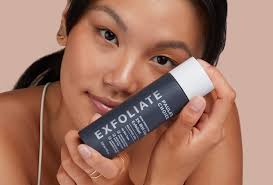
How Does a BHA Exfoliant Work?
Exfoliating facial acids have truly established themselves in almost everyone’s skincare routine. From cleansers, toners and leave-on products there is sure to be a product that will work in your regime and deliver a variety of skin benefits.
This leads us to today’s post and answering a few of your questions about BHA exfoliants and how they actually work. Beta hydroxy acid (BHA), also known as salicylic acid, is a potent facial acid that unlike, AHAs, is oil-soluble meaning it is able to work further down the layers of the skin making it able to unclog pores of any bacteria, dirt or excess sebum which in time leads to blemishes, blackheads and other forms of breakouts. It is also able to buff away any build-up of dead skin cells which can give the skin a dull, flaky and lack lustre appearance.
Don’t forget you can find out more about beta hydroxy acids over on our website.
How do you use a BHA exfoliant?
To use a BHA exfoliant really boils down to which product it is you are using that contains the acid in the formula. As previously mentioned, there are a selection of products to choose from.
Face Cleanser or Wash
Requires water and rinsing
Ideal for using in the mornings to help brighten the skin for the day ahead
Always follow with an SPF at the end of your routine to protect from any sun exposure
Can be used in the evening too which will allow the product to work at clearing away any build of bacteria, dirt and traces of product
Cleansers/washes are better for a skin type that experiences some dryness as the product is rinsed off the face treats the skin for a shorter amount of time
Exfoliating Toner
Used on a cotton disc and applied onto the skin
Generally a lot more potent than cleansers and can help the BHA penetrate further into the skin clearing clogged pores and bacteria build-up
Helps to slough away dead skin cell build-up that can make the skin appear dull
Can be used morning and evening if skin doesn’t show signs of sensitivity
Serum or Face Oil
Applied after cleansing the skin and before moisturiser
Can be used AM and PM
Serums and oils stay on the skin for a longer amount of time and will show results a lot quicker
This product is best used for those who suffer from an oilier skin type and frequent breakouts
When adding BHA into your skincare routine you must first ensure your skin will benefit from it and not suffer from any reactions. It is best to consult a dermatologist if you find your skin to be prone to extreme dryness and sensitivity.
Can I use a BHA exfoliant every day?
This is dependent on your skin type and percentage of salicylic acid in the product formulation. For over the counter (OTC) products there is usually a lower percentage than products given by prescriptions, for those who have a dry and sensitive skin type it is best to use BHA exfoliant as specified by a dermatologist or skincare professional.
For the most part, using an BHA exfoliant every day in your routine should result in a number of skin benefits, especially if you have an oily or blemish-prone skin type. Just ensure you keep the balance of water and oil levels in your skin by using hydrating and moisturising products which contain hyaluronic acid and niacinamide within your regime. If at any point you find your skin starts to feel tight, uncomfortable and dry than reduce the amount of times you apply BHA exfoliants allowing your skin to restore balance to the outer layer and protective skin barrier.
How long does it take to work?
You will find there are some instant results when using a product containing salicylic acid, particularly chemical toners. The skin will appear fresher looking with a healthy glow, in regards to treating any breakouts or other blemishes, you can expect to see results in 4-6 weeks. This is from the continuous usage of salicylic acid, especially if it is blended into a face serum that is applied in the evening. This will not only give the BHA longer time on the skin, but will also be able to work undisturbed from any contact with any free radicals and other skin damaging compounds such as, UV exposure and pollution.
Does BHA dry out skin?
BHA is highly potent and when formulated to active levels in a product becomes a powerhouse ingredient. This makes it highly effective at giving results to the skin, but can become very drying to the skin.
How to avoid BHA drying out the skin;
Ensure it is safe to use BHA on your skin type, if you have concerns consult a dermatologist
If you experience any tightness or dryness to the skin when using BHA reduce the amount of times you use that product allowing the skin to restore balance
Do not overuse a product containing BHA, let the percentage in the formula do the hard work, do not use extra amounts for quicker results. This will only lead to the skin become drier and suffer from more severe breakouts
Always use highly hydrating ingredients in your serums and moisturisers, this will allow the skin to remain comfortable and skin protective barrier working correctly
What should you do after using BHA?
After using BHA there are a couple of steps you need to take to allow the skin ingredient to have a beneficial effect. This also depends on which product contains the acid in it also as the following steps can alternate.
Face cleanser or wash- Follow this step with a good skincare routine containing hyaluronic acid or niacinamide to give the skin a hydration boost and protecting the outer layers of the skin.
Exfoliating toners- After applying a hydrating serum or moisturiser, ensure you have protected the skin from UV exposure with a SPF of 30 and above.
Serum or oil- Keeping the skin protected from sun exposure is vital, especially whilst using a serum or oil as the BHA will work on the skin continuously. Apply a layer of SPF during the day and ensure you cleanse the skin fully of an evening to avoid any product build-up.
There you have some answers to how does a BHA exfoliant work. You will find that once your skin has gained a good tolerance to this potent skin ingredient your complexion will look better than ever!


